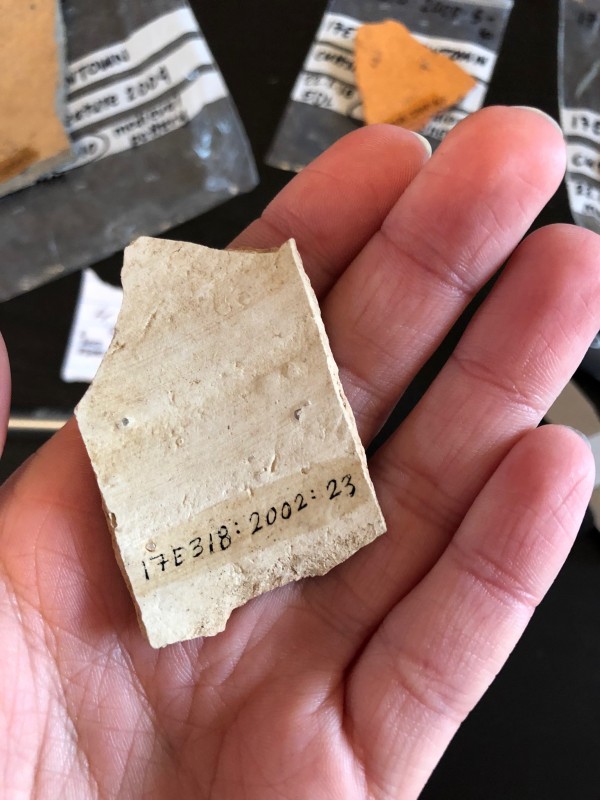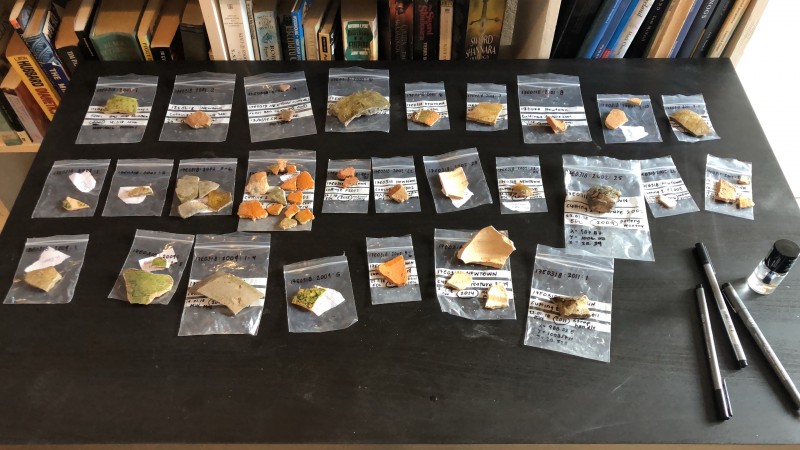July 18, 2018


In this penultimate blog, intern Madeleine Harris visits Birr Library, travels to Cork to meet with a medieval pottery specialist, visits the National Museum of Ireland in Dublin and meets with a conservator in University College Dublin.
by Madeleine Harris
This week was one of the busiest in Birr thus far, as we had meetings across the country and many things to accomplish. On Monday, I started the day by working with the samples we had sieved during the last day on site. Now that they were dry, I used tweezers to extract the bits of charcoal from the roots and other organic material and place it in a new bag. We are sending our charcoal to a lab in New Zealand where it will undergo radiocarbon dating. In order for us to send these samples out of the country, we had to submit permits to the National Museum of Ireland for export and alteration.
The majority of the Tuesday, I spent doing research and completing impact assessments. The library in Birr has a great local history section, which was of great use to me for my historical summary of the areas in my reports. At the end of the day, we gathered and prepared all of the items needed for the following day.
We had an early start on Wednesday, as we were meant to be in Bandon, a town just outside of Cork, by 9:30am. We scheduled a meeting with Clare McCutcheon, a medieval pottery specialist, who agreed to identify our pottery finds from Ferrycarrig; however, she did much more than that. We spent the whole day with Clare and not only learned which types of pottery we found, but how to identify them, their origin, and much more. Our sherds included Leinster Cooking Ware, Ham Green B ware, Wexford-type ware, Wexford-type coarseware, Saintonge green glazed ware, Bristol Redcliffe ware, Mintety-type ware, and even a couple sherds of Saintonge sgraffito. It was incredible to learn how she identified each sherd and I was grateful for the opportunity to spend the day with her. I now feel confident about identifying pottery sherds found on site, and am excited to share this knowledge with other students.
After our day with Clare, I spent most of Thursday working with the pottery. I took the information she shared and updated the museum database with the correct identifications. Once each piece was updated, I began labeling the sherds with their corresponding museum identification number. This number is a combination of the excavation license number, the feature or context number, and the individual find number (for example, 17E0318: 2001: 1) and is written on the pottery itself. To do this, I applied a varnish on each piece, let it dry, and then used a permanent pen to mark the number.
Friday was another early start, as we had various appointments in Dublin. Our first task was to view the topographical files inside the National Museum. These files contain a record of each artefact found in the country, and I needed the information to complete my impact assessments. In the afternoon, we went to University College Dublin to meet with Susannah Kelly, a conservator, to inquire about a piece of timber found on site. After asking a couple of people in the archaeology department about the artefact, we left the piece with her to conserve. It’s hard to believe I only have one week left in Ireland!